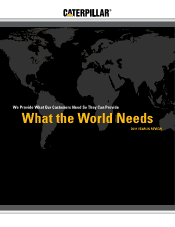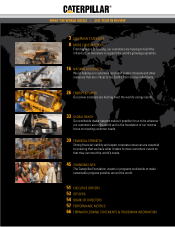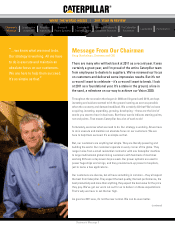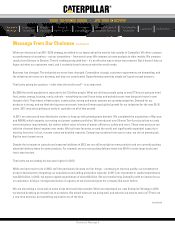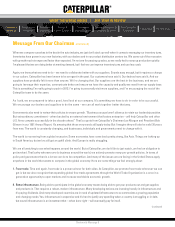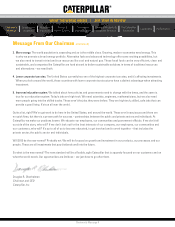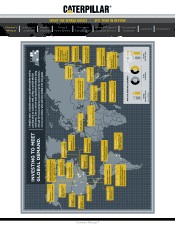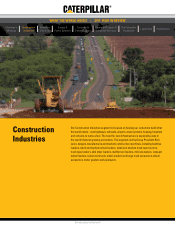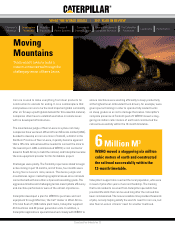Caterpillar 2011 Annual Report Download - page 11
Download and view the complete annual report
Please find page 11 of the 2011 Caterpillar annual report below. You can navigate through the pages in the report by either clicking on the pages listed below, or by using the keyword search tool below to find specific information within the annual report.
Construction Industries 11
WHAT THE WORLD NEEDS | 2011 YEAR IN REVIEW
Chairman’s
Message
Construction
Industries
Customer &
Dealer Support
Financial Products &
Corporate Services
The Caterpillar
Foundation Leadership Performance
Resource
Industries
Energy &
Power Systems
Iron ore is used to make everything from steel products for
construction to utensils for eating. It is so commonplace that
many believe iron ore to be the most important global commodity
after oil. To keep up with global demand for this essential material,
companies often have to establish worksites in remote areas
with no developed infrastructure.
The mountainous jungle of Sierra Leone is a place not many
companies have ventured. When African Minerals Limited (AML)
decided to develop an iron ore mine in Tonkolili, a district in the
Northern Province of Sierra Leone, it quickly became apparent
that a 125-mile railroad would be needed to connect the mine to
the nearest port. AML commissioned WBHO, a civil contractor
based in South Africa, to build the railroad, and Caterpillar became
the sole equipment provider for this formidable project.
Challenges were plenty. The Tonkolili project was slated to begin
active mining in just 12 months, and of those, four months were
during Sierra Leone’s rainy season. The dense jungle and
mountainous region created topographical issues since railroads
cannot be built with more than a 4 percent ascending grade. The
aggressive timeline and challenging terrain meant jobsite efficiency
and machine performance were of the utmost importance.
Caterpillar developed a plan for WBHO to purchase and rent
equipment through Mantrac, the Cat® dealer in West Africa.
Of a total fleet of 1,608 mobile plant items, Caterpillar supplied
412 machines and 20 power generation units. In addition, a
Caterpillar applications specialist worked closely with WBHO to
ensure machines were working efficiently to keep productivity
at the highest level. Articulated truck drivers, for example, were
given special training in order to operate fully loaded trucks
on steep grades so as not to damage the brakes. Caterpillar’s
complete presence at Tonkolili paid off. WBHO moved a stag-
gering six million cubic meters of earth and constructed the
railroad successfully within the 12-month timetable.
Caterpillar’s support also reached the local population, who were
in need of jobs after years of war and hardship. The training
that local residents received from Caterpillar specialists has
provided life skills that can be used long after the railroad has
been commissioned. The now accessible mine provides thousands
of jobs, not only helping satisfy the world’s need for iron ore, but
also Sierra Leone’s citizens’ need for a better livelihood.
Moving
Mountains
That’s what it takes to build a
mission-critical railroad through the
challenging terrain of Sierra Leone.
6 Million M3
WBHO moved a staggering six million
cubic meters of earth and constructed
the railroad successfully within the
12-month timetable.

